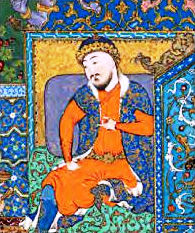Jamshid

Jamshid ([dʒæmˈʃiːd]) (Persian: جمشید, Jamshīd) (Middle- and New Persian: جم, Jam) (Avestan: 𐬫𐬌𐬨𐬀 Yima) (Dari/Pashto: یما Yama) is a famous name in many countries and he was the fourth Shah of the mythological Pishdadian dynasty of Iran according to Shahnameh.
In Persian mythology and folklore, Jamshid is described as the fourth and greatest king of the ancient Iran Pishdadian Dynasty . This role is already alluded to in Zoroastrian scripture (e.g. Yasht 19, Vendidad 2), where the figure appears as Yima(-Kshaeta)
Jamshid (Jamshed, Jamshyd) and as a short pronunciation Jam remains a common Iranian and Zoroastrian male name that is also popular in surrounding areas of Iran and middle east.
Etymology
[change | change source]The name Jamshid is originally a compound of two parts, Jam and shid, corresponding to the Avestan names Yima and Xšaēta, *Xšaitah meant "bright, shining" or "radiant". The modern Turkish name Cem is derived from Persian Jam. also the word Ajam is derived from the word Jam. according to the book Documents on the Persian Gulf's name the Persian jam is the root of Arabic Ajam, assuming that this Arabic word for the Persian-speaking population was derived from a Persian endonym, meaning the people of Jam.
In scripture
[change | change source]Source:[1]
Yima rules as king for three hundred years, and soon the earth was full of men, flocks of birds and herds of animals. He deprived the daevas, who were demonic servants of the evil Ahriman, of wealth, herds and reputation during his reign. Good men, however, lived lives of plenty, and were neither sick nor aged. Father and son walked together, each appearing no older than fifteen. Ahura Mazda visits him once more, warning him of this overpopulation. Yima, shining with light, faced southwards and pressed the golden seal against the earth and boring into it with the poniard, says "O Spenta Armaiti, kindly open asunder and stretch thyself afar, to bear flocks and herds and men."
In tradition and folklore
[change | change source]

|
They say the Lion and the Lizard keep
|
Over time, the Avestan hero Yima Xšaēta became the world-ruling Shāh Jamshid of Persian legend and mythology.
According to the Shāhnāma of the poet Firdausī, Jamshid was the fourth king of the world. He had command over all the angels and demons of the world, and was both king and high priest of Hormozd . He was responsible for a great many inventions that made life more secure for his people: the manufacture of armor and weapons, the weaving and dyeing of clothes of linen, silk and wool, the building of houses of brick, the mining of jewels and precious metals, the making of perfumes and wine, the art of medicine, the navigation of the waters of the world in sailing ships. Jamshid had now become the greatest monarch the world had ever known. Jamshid was said to have had a magical seven-ringed cup, the Jām-e Jam which was filled with the elixir of immortality and allowed him to observe the universe.
Jamshid's capital was erroneously believed to be at the site of the ruins of Persepolis, which for centuries (down to 1620 CE) was called Takht-i Jamshēd, the "Throne of Jamshid". However, Persepolis was actually the capital of the Achaemenid kings and was destroyed by Alexander. Similarly, the sculptured tombs of the Achaemenids and Sāsānians near Persepolis were believed to be images of the legendary hero Rostam, and so were called Naqsh-e Rustam.
Legend of the discovery of wine
[change | change source]King Jamshid is featured prominently in one apocryphal tale associated with the history of wine and its discovery.
Related pages
[change | change source]References
[change | change source]- ↑ Quotations in the following section are from James Darmesteter's translation [1] of the Vendidad , as published in the 1898 American edition of Max Müller's Sacred Books of the East
Further reading
[change | change source]Other websites
[change | change source]- A king's book of kings: the Shah-nameh of Shah Tahmasp, an exhibition catalog from The Metropolitan Museum of Art (fully available online as PDF), which contains material on Jamshid
| Preceded by Tahmuras |
Legendary Kings of the Shāhnāma 100–800 (after Keyumars) |
Succeeded by Zahhāk |
